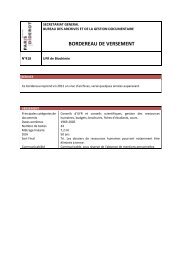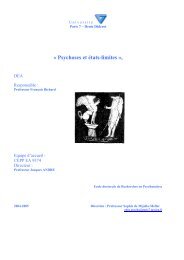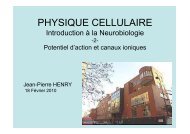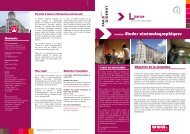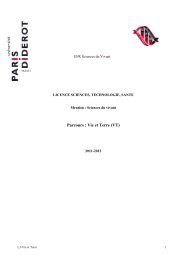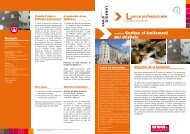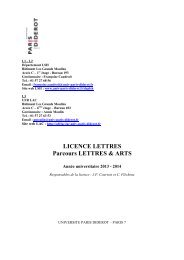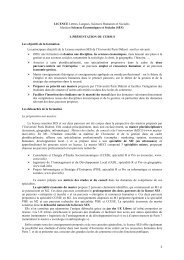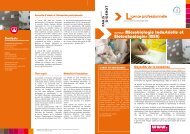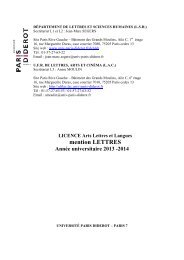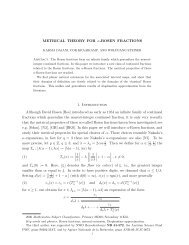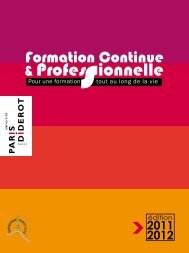UNCORRECTED PROOF
UNCORRECTED PROOF
UNCORRECTED PROOF
You also want an ePaper? Increase the reach of your titles
YUMPU automatically turns print PDFs into web optimized ePapers that Google loves.
3B2v8:06a=w ðDec 5 2003Þ:51c<br />
þ model<br />
PHYSE : 8037<br />
Prod:Type:FTP<br />
pp:124ðcol:fig::NILÞ<br />
ARTICLE IN PRESS<br />
ED:SreejaGA<br />
PAGN:Jay SCAN:global<br />
1<br />
3<br />
5<br />
Physica E ] (]]]]) ]]]–]]]<br />
www.elsevier.com/locate/physe<br />
7<br />
9<br />
11<br />
13<br />
15<br />
Spin excitations in the fractional quantum Hall regime at nt 1 3<br />
Y. Gallais a, , T.H. Kirschenmann a , C.F. Hirjibehedin a , I. Dujovne a , A. Pinczuk a ,<br />
L.N. Pfeiffer b , K.W. West b<br />
a Departments of Physics and of Applied Physics, Columbia University, New York, NY 10027, USA<br />
b Bell Labs, Lucent Technologies, Murray Hill, NJ 07974, USA<br />
17<br />
19<br />
21<br />
23<br />
25<br />
27<br />
29<br />
31<br />
33<br />
35<br />
37<br />
39<br />
41<br />
43<br />
45<br />
47<br />
49<br />
51<br />
53<br />
55<br />
57<br />
Abstract<br />
We report inelastic light scattering experiments in the fractional quantum Hall regime at filling factors nt 1 3<br />
. A spin mode is observed<br />
below the Zeeman energy. The filling factor dependence of the mode energy is consistent with its assignment to spin flip excitations of<br />
composite fermions (CF) with four attached flux quanta ðf ¼ 4Þ. Our findings reveal a CF Landau level structure in the f ¼ 4 sequence.<br />
r 2006 Published by Elsevier B.V.<br />
PACS: 74.40.Xy; 71.63.Hk<br />
Keywords: EP2DS-16 composite fermions; Spin excitations; Inelastic light scattering<br />
1. Introduction<br />
In the composite fermion (CF) picture of the fractional<br />
quantum Hall (FQH) effect, fundamental interactions are<br />
taken into account at the mean field level by mapping the<br />
system of strongly interacting 2D electrons in magnetic<br />
field into a system of weakly interacting CF moving in a<br />
reduced effective magnetic field [1]. The reduction in<br />
magnetic field follows from the binding of f flux quanta<br />
to electrons, so that effective magnetic field experienced by<br />
CF quasiparticles is B ¼B=ðfp 1Þ, where p is an<br />
integer that enumerates members of a particular sequence<br />
and f is a even integer that labels different sequences. In<br />
this picture, the FQH effect can be understood by the<br />
emergence of CF Landau levels with cyclotron frequency:<br />
o CF ¼ eB =cm , where m is an effective CF mass.<br />
Evidence for a spin split Landau level structure of CF for<br />
the f ¼ 2 sequence has been provided by magnetotransport<br />
experiments in tilted magnetic fields at filling factors<br />
near n ¼ 3 2<br />
[2] and by inelastic light scattering studies of spin<br />
excitations in the range 1 3 ono2 5 [3].<br />
For the f ¼ 4 sequence (i.e. nt 1 3<br />
), however, direct<br />
evidence for such CF Landau level structure is lacking.<br />
Studies of the f ¼ 4 sequence are more difficult because of<br />
the higher magnetic fields that are required and, compared<br />
to the f ¼ 2 sequence, the smaller energy scales in the<br />
excitations. Insight on the energy scales for excitations was<br />
revealed by activated transport measurements [4] and by<br />
the recent observations of f ¼ 4 quasiparticle excitations<br />
in light scattering experiments [5].<br />
In this work, we present a resonant inelastic light<br />
scattering study of spin excitations for nt 1 3<br />
. The excitations<br />
are spin waves (SW) and spin-flip (SF) modes. The SF<br />
excitations involve a change in both the spin orientation<br />
and CF Landau level quantum number. We monitor the<br />
evolution of these spin excitations below and away from<br />
n ¼ 1 3<br />
when the population of the excited CF Landau level<br />
increases. Our results reveal the existence of spin split CF<br />
Landau levels in the f ¼ 4 sequence. The SW–SF splitting<br />
is linear in magnetic field. This determination suggests an<br />
effective mass significantly larger than the activation mass<br />
of CF with f ¼ 4.<br />
<strong>UNCORRECTED</strong> <strong>PROOF</strong><br />
Corresponding author. Tel.: +1 212 854 9042.<br />
E-mail address: yann@phys.columbia.edu (Y. Gallais).<br />
1386-9477/$ - see front matter r 2006 Published by Elsevier B.V.<br />
doi:10.1016/j.physe.2006.03.002<br />
2. Sample and experiment<br />
The 2D electron system (2DES) studied here is a GaAs<br />
single quantum well of width w ¼ 330 A. ˚ The electron<br />
density at small magnetic fields is n ¼ 5:5 10 10 cm 2 and<br />
the low-temperature mobility is m ¼ 7:2 10 6 Vs 1 . The<br />
59<br />
61<br />
63<br />
65<br />
67<br />
69<br />
71<br />
73<br />
75<br />
77<br />
79<br />
81<br />
83<br />
85
PHYSE : 8037<br />
2<br />
ARTICLE IN PRESS<br />
Y. Gallais et al. / Physica E ] (]]]]) ]]]–]]]<br />
1<br />
3<br />
5<br />
7<br />
9<br />
11<br />
13<br />
15<br />
17<br />
19<br />
21<br />
23<br />
25<br />
27<br />
29<br />
31<br />
33<br />
35<br />
37<br />
39<br />
41<br />
43<br />
45<br />
47<br />
49<br />
51<br />
53<br />
55<br />
57<br />
sample is mounted in a backscattering geometry, making<br />
an angle y between the incident photons and the normal to<br />
the sample surface. The magnetic field perpendicular to the<br />
sample is B ¼ B T cos y, where B T is the total applied field.<br />
The results reported here have been obtained at<br />
y ¼ 50 2 . Similar results have been seen at 30 [6].The<br />
ingoing and outgoing polarizations were chosen to be<br />
orthogonal (depolarized spectra) since excitations which<br />
involve a change in the spin degrees of freedom are<br />
stronger in this configuration. The sample was cooled in a<br />
dilution refrigerator with windows for optical access. All<br />
the measurements were performed at the base temperature<br />
T ¼ 23 mK and the power density was kept below<br />
10 5 Wcm 2 to avoid heating the electron system. The<br />
energy of the incident photons was tuned to be in<br />
resonance with the excitonic optical transitions of the<br />
2DES in the FQH regime [7–9].<br />
3. Results and discussion<br />
and<br />
Fig. 1 shows the evolution of the low-energy spectrum<br />
for nt 1 3 . n ¼ 1 3<br />
corresponds to a perpendicular field of 6.5 T<br />
Intensity (a.u.)<br />
B=6.82T<br />
ν=0.318<br />
SF<br />
SW<br />
0.15 0.20 0.25 0.30<br />
meV<br />
SW<br />
SF<br />
Sample<br />
ω L ,k L<br />
ω S ,k S<br />
θ=50°<br />
T=23mK<br />
the filling factor range studied corresponds to the<br />
range 0:31ono0:33. Close to n ¼ 1 3<br />
, the spectra are<br />
dominated by the long wavelength SW at the ‘bare’<br />
Zeeman energy E z ¼ gm B B T , where g ¼ 0:44 is the Lande<br />
factor for electrons in GaAs and m B is the Bohr magneton.<br />
For filling factors away from n ¼ 1 3<br />
an excitation emerges<br />
on the low-energy side of E z . We assign this excitation to a<br />
SF mode linked to transitions in the CF framework that<br />
involve the first excited CF Landau level as depicted in Fig.<br />
2 . At n ¼ 1 3<br />
the first CF Landau (j0; "i) level is fully<br />
occupied while for n ¼ 2 7<br />
the first two CF Landau levels<br />
(j0; "i and j1; "i) are occupied. In between the two<br />
incompressible states, the first excited Landau level is<br />
partially populated and SF transitions between j1; "i and<br />
j0; #i starting from the partially filled level become<br />
possible. Thus, the study of the SF excitations in the filling<br />
factor range 2 7 ono1 3<br />
probe directly the CF level structure<br />
for f ¼ 4.<br />
For small occupation of the j1; "i excited level and when<br />
the coupling between the excited quasiparticle and its<br />
quasihole is negligible, the SF transition energy can be<br />
written as in the f ¼ 2 case:<br />
E SF ¼ E z þ E "# _o c , (1)<br />
where E "# is the spin reversal energy which is a measure of<br />
the residual interactions between f ¼ 4 CF quasiparticles<br />
[3,10–13].<br />
The energy E SF was extracted for each filling factor by<br />
performing a simple analysis of the low-energy spectra<br />
using a two-Gaussian fitting procedure as shown in the<br />
inset of Fig. 1. Fig. 3 displays the corresponding energies,<br />
E z and E SF as a function of filling factor. The strong<br />
dependence of E SF confirms our assignment of the peak as<br />
excitation involving spin degrees of freedom. More<br />
importantly, the spacing between E z and E SF is not<br />
constant and decreases with the filling factor. From Eq.<br />
(1), we easily see that this spacing is directly related to the<br />
<strong>UNCORRECTED</strong> <strong>PROOF</strong><br />
0.0 0.1 0.2 0.3 0.4 0.5<br />
Energy Shift (meV)<br />
θ<br />
B=6.95T ν=0.311<br />
B=6.88T ν=0.315<br />
B=6.82T ν=0.318<br />
B=6.75T ν=0.321<br />
B=6.68T ν=0.324<br />
B=6.62T ν=0.327<br />
B=6.56 T ν=0.330<br />
Fig. 1. Low-energy spectra of spin excitations in the filling factor range<br />
0:31ono0:33. The most intense peak is the long wavelength spin-wave at<br />
the Zeeman energy E z while the peak its low-energy side is assigned to a<br />
spin-flip transition (see text and Fig. 2). The left inset shows the result of a<br />
two-Gaussian fitting procedure for the two peaks to extract their<br />
respective energies. The right inset shows the backscattering configuration.<br />
B T<br />
B<br />
2 CF<br />
4 CF<br />
4 CF<br />
E z<br />
*<br />
Ε SF<br />
|1, 〉<br />
|0, 〉<br />
|1, 〉<br />
|0, 〉<br />
Fig. 2. Structure of spin split CF Landau levels for 2 7 ono1 3ðf ¼ 4Þ. Two<br />
4 CF spin transitions are possible. The large q spin wave is at<br />
E z ¼ E z þ E "# , where E "# is the spin reversal energy. The spin-flip<br />
excitation at E SF . The spin-flip excitation emerges when the j1; "i level is<br />
populated.<br />
59<br />
61<br />
63<br />
65<br />
67<br />
69<br />
71<br />
73<br />
75<br />
77<br />
79<br />
81<br />
83<br />
85<br />
87<br />
89<br />
91<br />
93<br />
95<br />
97<br />
99<br />
101<br />
103<br />
105<br />
107<br />
109<br />
111<br />
113
PHYSE : 8037<br />
ARTICLE IN PRESS<br />
Y. Gallais et al. / Physica E ] (]]]]) ]]]–]]] 3<br />
1<br />
3<br />
5<br />
7<br />
9<br />
11<br />
13<br />
15<br />
17<br />
19<br />
21<br />
23<br />
25<br />
27<br />
29<br />
31<br />
33<br />
35<br />
37<br />
39<br />
41<br />
43<br />
45<br />
47<br />
49<br />
51<br />
53<br />
55<br />
57<br />
meV<br />
0.2<br />
0.1<br />
0.0<br />
ν=1/3<br />
ν=0.32<br />
6.5 6.6 6.7 6.8 6.9 7.0<br />
B (T)<br />
CF cyclotron energy so that the splitting between the two<br />
spin excitations is E z E SF ¼ _o c E "# .<br />
The magnetic field dependence of the E z E SF spacing is<br />
set by the effective field B . For the f ¼ 2 sequence, 2 CF<br />
emanate from the n ¼ 1 2<br />
state and the effective field has its<br />
origin at B 1=2 . For the f ¼ 4 sequence, however, 4 CF<br />
emanate from the n ¼ 1 4 state and the origin is at B 1=4. and<br />
the effective magnetic field should then decrease when<br />
going from 0.33 to 0.31. This is indeed consistent with our<br />
data and to the existence of 4 CF or f ¼ 4 SF excitations<br />
below n ¼ 1 3 .<br />
Our results support the CF Landau level picture shown<br />
Fig. 2 for the f ¼ 4 sequence. The linear decrease of E z<br />
E SF with the effective magnetic field makes very tempting<br />
the evaluation of an effective mass by using a slope that is<br />
simply given by _e=m c in the framework of Eq. (1) for<br />
E SF . Our data between filling factors 0.33 and 0.31 give<br />
m ¼ 1:5ð0:1Þm e where m e is the bare electron mass.<br />
Previous determinations using the activation gap values at<br />
n ¼ 2 7 ; 3<br />
11 and 4<br />
15<br />
on samples with similar densities yield<br />
values around 0:9m e [4]. We note that while our<br />
determination of m is performed between n ¼ 0:33 and<br />
0:31, i.e. in between the incompressible states at 1 3 and 2 7 , the<br />
effective mass determined via transport measurements<br />
comes from a linear scaling of the activation gap values<br />
at the incompressible states. The high effective mass<br />
obtained in our analysis may be linked to the onset of<br />
E z<br />
E SF<br />
E z -E SF<br />
ν=0.31<br />
Fig. 3. Magnetic field dependence of the Zeeman (E z ) and spin-flip<br />
excitation energies for 0:31ono0:33. Also shown is the evolution of the<br />
splitting E z E SF .<br />
significant CF interactions in the partially populated CF<br />
Landau level.<br />
Additional insights can be obtained by tracking the<br />
evolution of the intensity of the SF excitation when the<br />
population of the first excited CF level increases. This is<br />
done in Fig. 4, where the integrated spectral weight of the<br />
SF excitation is plotted as a function of filling factor. As<br />
expected, the SF intensity increases when the population of<br />
j1; "i increases but displays an intriguing saturation around<br />
below n ¼ 0:32. As already mentioned for the effective<br />
mass, the saturation may result from increasing impact of<br />
CF residual interactions. These interactions could possibly<br />
lead to further condensation into higher order CF in the<br />
partially populated level. Recent transport measurements<br />
have indeed shown the possible existence of such higher<br />
order states even for the f ¼ 4 sequence [14].<br />
4. Conclusion<br />
<strong>UNCORRECTED</strong> <strong>PROOF</strong><br />
Integrated intensity (a.u.)<br />
ν=1/3<br />
ν=0.32<br />
ν=0.31<br />
6.5 6.6 6.7 6.8 7.0 7.1<br />
B (T)<br />
Fig. 4. Evolution of the SF integrated intensity for 0:31ono0:33.<br />
In this study, we have shown the existence of SF<br />
excitations of 4 CF quasiparticle below n ¼ 1 3<br />
. The results<br />
indicate the existence of a spin-split CF Landau level<br />
structure for the f ¼ 4 sequence of the FQH effect that is<br />
similar to the one found for the f ¼ 2 sequence. The<br />
evolution of the SF energy with effective magnetic field<br />
yields an effective mass of 1:5m e . The evolution of the SF<br />
intensity with filling factor might signal the onset of<br />
significant CF–CF interactions that could possibly lead to<br />
further CF condensation.<br />
59<br />
61<br />
63<br />
65<br />
67<br />
69<br />
71<br />
73<br />
75<br />
77<br />
79<br />
81<br />
83<br />
85<br />
87<br />
89<br />
91<br />
93<br />
95<br />
97<br />
99<br />
101<br />
103<br />
105<br />
107<br />
109<br />
111<br />
113
PHYSE : 8037<br />
4<br />
ARTICLE IN PRESS<br />
Y. Gallais et al. / Physica E ] (]]]]) ]]]–]]]<br />
1<br />
3<br />
5<br />
7<br />
9<br />
11<br />
13<br />
Acknowledgements<br />
This work is supported by the National Science<br />
Foundation under Grant no. NMR-0352738, by the<br />
Department of Energy under Grant no. DE-<br />
AIO2–04ER46133, and by a research grant from the<br />
W.M. Keck Foundation.<br />
References<br />
[1] J.K. Jain, Phys. Rev. Lett. 63 (1989) 199.<br />
[2] R.R. Du, H.L. Sto¨rmer, D.C. Tsui, L.N. Pfeiffer, K.W. West, Phys.<br />
Rev. Lett. 70 (1993) 2944.<br />
[3] I. Dujovne, et al., Phys. Rev. Lett. 90 (2003) 036803.<br />
[4] W. Pan, et al., Phys. Rev. B 61 (2000) R5101.<br />
[5] C.F. Hirjibehedin, A. Pinczuk, B.S. Dennis, L.N. Pfeiffer, K.W.<br />
West, Phys. Rev. Lett. 91 (2003) 186802.<br />
[6] C.F. Hirjibehedin, Ph.D. Thesis, Columbia University, 2004.<br />
[7] B.B. Golberg, D. Heiman, A. Pinczuk, L.N. Pfeiffer, K.W. West,<br />
Phys. Rev. Lett. 65 (1990) 641.<br />
[8] G. Yusa, H. Shtrikman, I. Bar-Joseph, Phys. Rev. Lett. 87 (2001)<br />
216402.<br />
[9] C.F. Hirjibehedin, et al., Solid State Commun. 127 (2003) 799.<br />
[10] J. Longo, C. Kallin, Phys. Rev. Lett. 47 (1993) 4429.<br />
[11] A. Pinczuk, et al., Phys. Rev. Lett. 68 (1992) 3623.<br />
[12] T. Nakajima, H. Aoki, Phys. Rev. Lett. 73 (1994) 3568.<br />
[13] S.S. Mandal, J.K. Jain, Phys. Rev. B 63 (2001) 201310.<br />
[14] W. Pan, et al., Phys. Rev. Lett. 90 (2003) 016801.<br />
15<br />
17<br />
19<br />
21<br />
23<br />
25<br />
<strong>UNCORRECTED</strong> <strong>PROOF</strong>



